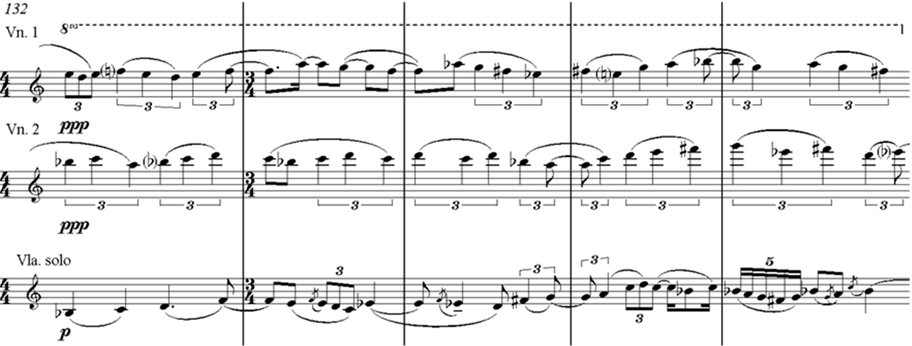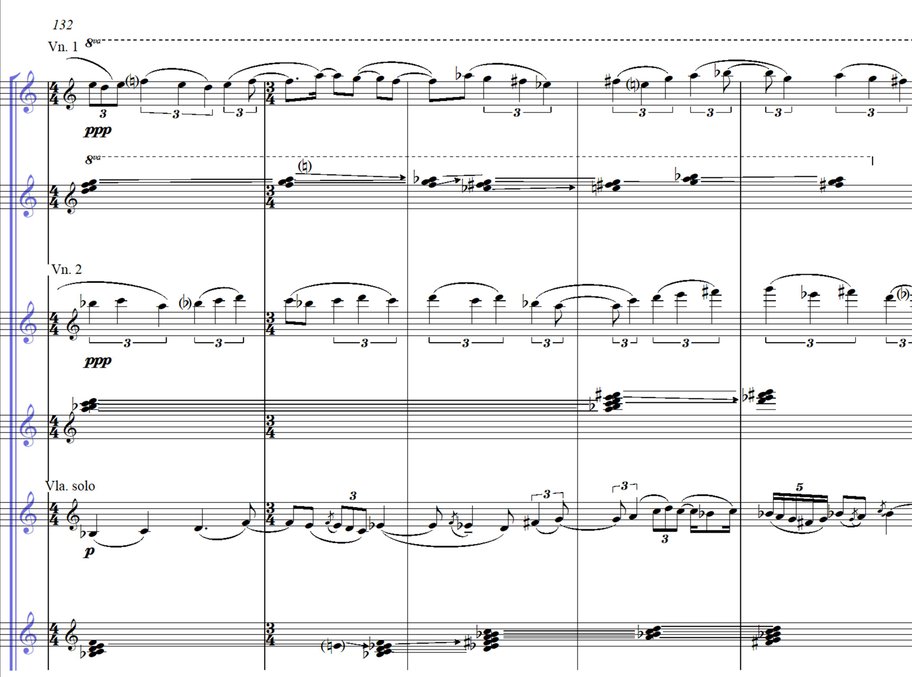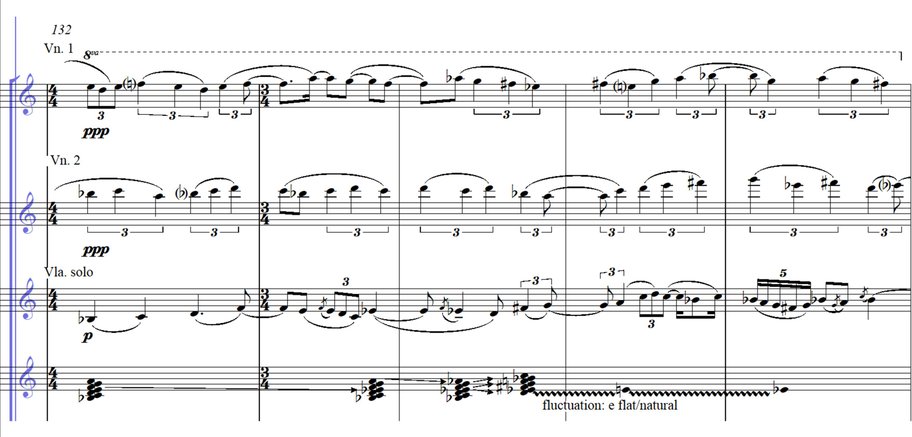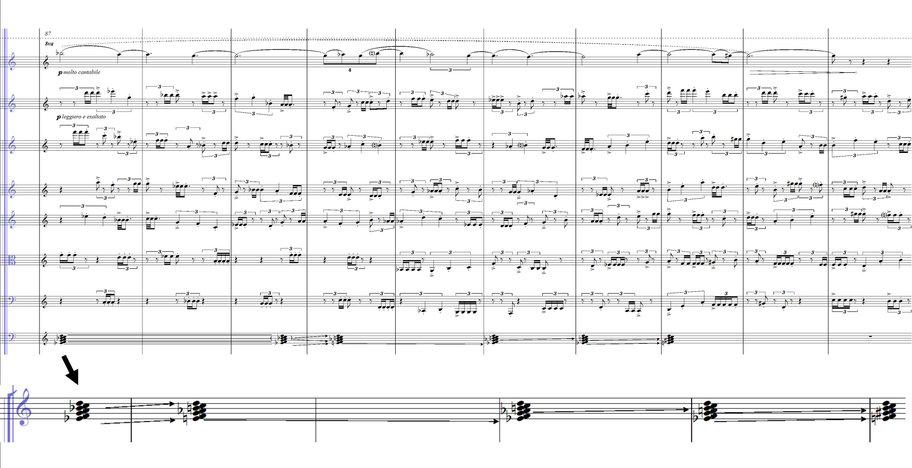Figure 8: The Sacred Flight, measures 87-96. Reduction:
Top stave: Violins 1 and 2
Staves 2 to 7: Winds and Brass
Bottom stave: pitch reduction of the morphomodal network. That stave is then enlarged at the bottom of the figure as it appears too small in the score excerpt above it.
___________________________________________________
In Figure 8, two main elements are present within the overall texture: a melodic line in the first violins and a punctuated texture in the winds and brass. In fact, each of the wind and brass parts follows a kind of a line of its own. This line is, however, perforated by silences and thus transformed into a series of punctuated motifs. Thus the linear aspect disappears and all the parts merge into a twinkling texture which sounds like a background to the melodic line in the first violins. Again, the pitch content of all lines is constrained to the pitches of the background morhpomodal network (bottom stave) and again the changes of harmony do not appear instantly, but their margins are blurred by the nature of the interaction between the background morphing modal network/matrix and the foreground texture. As for the matrix itself – it could hardly be described as a chord progression and, if played as a succession of verticals, it would not make much musical sense. Although I do use verticals in a particular way, (Chapter 2.2) none are employed in this example and no verticals could be heard as relevant components of this texture due to its rapidly changing, linear nature, for which the horizontal morphomodal harmony is an ideal means of harmonic control. But before I discuss the particular relevance of verticals in this approach I would like to reflect first upon the nature of the ‘modes’.
It is apparent that some of these modes (in Figures 7,8) are diatonic, while others are not. A group of non-diatonic modes employed throughout my work are those which contain augmented seconds, such as the second, third and last pitch collections in Figure 8. This group of modes is typical of the Second and Sixth Tone in Eastern Chant.77 (click) This type of modes is also typical of the maqamat system and employed in traditional music across a large region of the East. They are also frequently used in folk music across the Balkans and other parts of Eastern Europe. Although sometimes they are referred to as ‘oriental scales’, their origin is most probably Ancient Greek, because modes with augmented seconds are first described in Ancient Greek treatises as the scales of the chromatic genus.78 (click) They have been employed in Eastern Orthodox Christian Chant at least since the early fourteenth century (but probably much earliear), according to the most recent research on this matter, which rejects the notion that they were introduced to Eastern Chant during the Ottoman conquest.79 (click) Furthermore, as it was discussed above, the maqamat system is itself grounded upon the Ancient Greek modal system both theoretically and practically and it is evident that this type of scale with augmented seconds is Ancient Greek in origin, if not even older. In the Common-Practice tonal context, the augmented second in the scale of the harmonic minor key is also widely used. For example the first theme to the first movement of Mozart’s 40th Symphony is particularly famous for it. For all these reasons I consider quite irrelevant the ‘ethnic’ label that is sometimes attached to scales with augmented seconds. In my music they are a valuable source of diversity and the position of the augmented seconds in the network is not confined only to the places where it might traditionally appear in Eastern or Western traditions, but is used with unlimited variability.
Certain untempered and microtonal modal features which are also typical for Eastern Chant have also been integrated within my approach and will be discussed in Chapter 5.
Furthermore, the modes that I use are far from confined to what is pertinent to Chant or Folksong traditions alone. In the morphing process new modes emerge. Some of them are similar or identical to non-traditional modes and scales used by twentieth-century composers like Bartok, Britten and Messiaen for example. Other ones are completely idiosyncratic. However, all those pitch collections are thoroughly integrated in the process of morphing which interconnects them in a logical way.
Thus the concept of ‘mode’ in my work is very broad. The scales of these modes80(click) could be defined as pitch collections which are constituted by consecutive intervals with sizes ranging between a microtonal second and an augmented second, in which no more than two intervals of minor second or smaller microtonal second appear consecutively, and no intervals larger than a major second appear in more than one instance consecutively.81 (click) In many but not all instances, these scales have a cyclic periodic structure. The octave periodicity of the scale cycle is not ubiquitous in Eastern Chant, and in my music too, and modes can be fifth-repeating, fourth-repeating etc. in their cyclic structure in the Eastern Chant tradition, as well as in the finale of my Third Percussion Concerto, or A Seasong, (to be discussed in Chapter 6.1). Furthermore, it will be seen that sometimes I use ‘modes’ which comprise of 3 or 4 scale degrees only, which are, however, organised around a modal centre and are a valuable resource for composition (to be discussed in Chapter 4.1).
Because this concept of mode is very broad I do not feel limited in a negative way when working with this method, as I have a vast amount of pitch collections to hand and a very logical way to interconnect them within the morphomodal network. Furthermore, as that is only an imaginative, ‘background’ network, it can be revealed in an infinite number of ways through the foreground texture. Thus the use of this method can extend towards the atonal and tonal82 (click) domains, which I will discuss in Chapter 3 and Chapter 4.
This approach to pitch organisation has also a certain degree of similarity to Ligeti’s approach in a group of works which are termed by Roig-Frankolí as ‘net-structure compositions’.83 (click) The concept of net structure is not limited to pitch only, but in regard to pitch Ligeti describes his approach in these works as working ‘to a skeleton’. 84 (click) Elsewhere he describes the overall process as a ‘progressive metamorphosis of intervallic constellations’,85 (click) which approach is very similar to the background morphing modal network used by me. There are also many differences between my approach and Ligeti’s one, but a systematic and thorough discussion would be lengthy and is beyond the scope of this commentary. More comprehensive information could be derived from analysing the scores provided in this portfolio. I must say, however, that Ligeti’s music has been a great inspiration for me and I have also dedicated an earlier symphonic work of mine86 (click) to his memory. His influence on my work generally is more apparent in an earlier group of compositions of mine (including the 2006 memorial piece) and has certainly left some traces (although less marked) in the works presented here.
The apparent similarity between his ‘metamorphosis of intervallic constellations’ and the traditional background process of transforming modal network, codified in the notation of Eastern Chant through the phtoric neumes is also fascinating to me (particularly as I am not aware of him stating that he was aware in such detail of the Byzantine Chant tradition).
There are also significant differences between my approach and his, and the most obvious is in the nature of the pitch collections. Ligeti’s ‘pitch constellations’, are developed upon an intervallic approach influenced by Bartok and the Second Viennese School composers87 (click) and only some of them, only partially resemble modes of any kind.
In my approach, in contrast, the pitch collections are generally modes in the traditional sense, 88 (click) although the nature of their pitch structure is stretched very far (but not infinitely), as discussed above. However, in this great variety of pitch collections that I use, there is a main core which is diatonic or similar to diatonic. This is certainly a matter of choice and that choice I have made after many years of contemplation about my practices, having worked with tonal and atonal techniques, including 12-tone serialism. As the choice I made is both an intuitive choice and an informed choice, I will discuss some of the important factors that have informed it in the following section of this chapter. But before that I would like to reflect very briefly upon the process of searching and upon some technological issues from my own perspective.
Although there are earlier works of mine which are either exclusively serialist or exclusively/predominantly tonal (with modal influences), in a significant number of my works I have combined various techniques in eclectic mixes. The period immediately preceding the works in this thesis was also marked by extensive use of controlled aleatorics of a type similar to that of Kazandjiev, Iliev, Penderecki, Lutosławski, in which approach the foundations of the current method started to take shape.
The main advantage that I feel in the method of morphing modality presented here, is that in working with it I do not need to switch between different pitch organisation techniques. As the contrasts that I require aesthetically are often very wide, I have found it necessary in the past to switch between tonal and atonal pitch organisation within a single work, which often produced an eclectic result. However, morphing modality could extend, if necessary, towards both quasi-atonality and quasi-tonality without twisting, (Chapters 2.1, 4.3) while the common ground of modality is by nature very flexible and diverse. I have also found that within this method, in the process of morphing, transitions between more ‘consonant’ and more ‘dissonant’ sonorities could be done either gradually or rapidly, but in both cases maintaining an integral connection between them in the background pitch formation process.
It is also important for me that this background process is completely internalized89 (click) and this way it allows for a wide margin of intuitive, internalized choices, which are less predetermined by the specifics of the method. This emphasis on intuitive freedom (restricted only by principles grounded in nature, as it will be discussed below) is a matter of personal choice which I have made after years of experimentation. At the present stage of development of my compositional method I attribute a prime importance to intuition and I value highly the unconscious process. For me it is not inferior to the conscious process, as far as composition is concerned, and it can even account for more complex and intrinsically logical choices than those that we make within the conscious thinking.
I believe also that within the intuitive ground there exists a particular kind of interaction with a factor of inspiration that could not be researched, as it is beyond comprehension, but its importance to my work I could not leave unmentioned. As this is a completely personal view which I will not elaborate further here, I will leave the ideas expressed in the works of music in this thesis to shed light on that aspect of faith, as they can do that more naturally than a verbal text.





